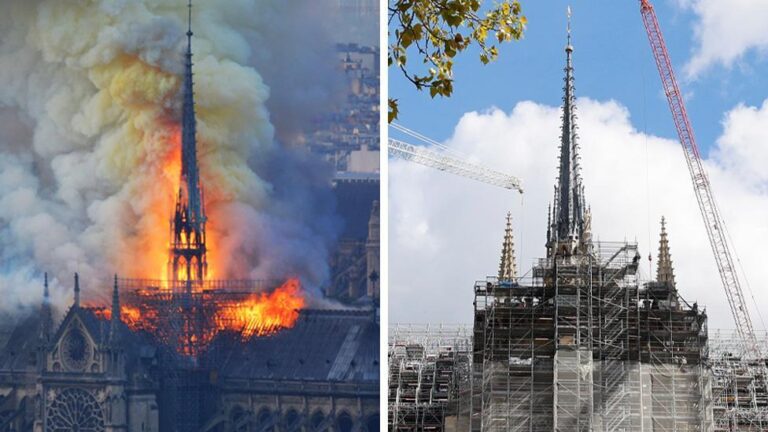French firefighters have swiftly mobilized to combat a significant blaze that erupted at the historic Rouen Cathedral, one of Normandy’s most iconic landmarks. The fire broke out in the early hours, prompting an immediate response from emergency services as they worked tirelessly to contain the flames and safeguard the centuries-old structure. Rouen Cathedral, known for its stunning gothic architecture and rich history, has faced various challenges over the years, but this latest incident raises concerns over the preservation of cultural heritage amidst the ongoing struggle against fire hazards in historic sites. As firefighters continue to battle the blaze, the community watches with bated breath, hoping for a swift resolution and minimal damage to this architectural treasure.
French Firefighters Tackle Blaze at Historic Rouen Cathedral
Firefighters in France are facing a daunting challenge as they work to extinguish a significant blaze that erupted at the iconic Rouen Cathedral. The inferno, which began in the early hours, has engulfed a portion of the building, necessitating an immediate emergency response. Dozens of firefighters have been deployed to combat the flames, employing both aerial and ground strategies to protect the historic structure, which has been a cultural landmark for centuries. Key efforts include:
- Deployment of water hoses from diverse angles
- Utilization of aerial ladders for hard-to-reach areas
- Evacuation of nearby buildings to ensure public safety
The cause of the fire remains under investigation, but officials are working diligently to manage the situation. Residents and visitors alike have been urged to stay clear of the area as firefighters continue their efforts. Authorities emphasize the importance of preserving the cathedral, famous for its stunning Gothic architecture and impressive stained glass, underscoring the cultural and historical significance of this site. A local architect stated, ‚ÄúThe cathedral is not just a landmark; it is a part of our identity.‚ÄĚ As the situation develops, updates will be provided to keep the public informed.
Response Strategies Employed in Cathedral Firefighting Efforts
The efforts to combat the fire at Rouen Cathedral mobilized a considerable number of firefighters, highlighting a coordinated approach to tackling the blaze. Fire squads employed a combination of aerial and ground strategies to effectively battle the flames while minimizing further damage to the historic structure. Notably, the use of water cannons from elevated platforms enabled a targeted assault on the fire’s source, ensuring that both the interior and exterior of the cathedral were addressed simultaneously. Ground teams diligently worked to create safe zones, facilitating both fire control and evacuation of nearby areas if necessary.
In addition to physical firefighting methods, the command hierarchy played a crucial role in the operation’s success. On-site incident commanders implemented strict protocols, ensuring effective communication between units. Firefighters utilized modern technology, including drones, to assess damage and monitor hotspots from above. The integration of these tools alongside traditional firefighting tactics showcased a dynamic response strategy. The overall effort was characterized by a unified front, as specialized units coordinated efforts, employing rapid assessments to adjust tactics in real-time.
Impact on Heritage Conservation and Community Sentiment
The recent inferno at Rouen Cathedral not only threatened the structural integrity of this historical monument but also evoked deep emotional responses within the local community. Residents and preservationists alike expressed their unease, fearing the loss of a landmark that represents centuries of history and artistry. The cathedral, home to remarkable Gothic architecture and a site of cultural significance, has become a focal point for community identity, symbolizing resilience and continuity through turbulent times. Many locals gathered to witness the firefighters’ efforts, their hearts heavy with the possibility that a beloved icon could be lost to flames.
In light of this incident, conversations around heritage conservation are intensifying. Stakeholders are urging proactive measures to safeguard historical sites, including:
- Increased Funding: Advocating for more financial resources dedicated to restoration and fire prevention.
- Enhanced Regulations: Implementing stricter safety standards for heritage buildings.
- Community Engagement: Involving local citizens in preservation efforts to foster a shared sense of responsibility.
The potential repercussions of this event on community sentiment are palpable. The fear of losing heritage can catalyze community activism, with residents more likely to rally together in support of local preservation initiatives. As the smoke clears and the true extent of the damage becomes clear, one thing remains certain: Rouen Cathedral will continue to be a symbol of hope and resilience, igniting a renewed commitment to safeguarding cultural treasures.
Recommendations for Enhancing Fire Safety in Historic Structures
To mitigate the risk of fire in historic structures, particularly those revered for their architectural significance, it is crucial to implement a series of proactive measures. Regular inspections of electrical systems and heating equipment can significantly reduce the likelihood of ignition. Furthermore, the integration of advanced fire detection systems tailored to the unique demands of heritage buildings will aid in early fire identification. Maintenance of firebreaks and fire-resistant materials can protect vital features from being compromised. Collaboration with conservation experts ensures that modifications do not detract from the original architecture while enhancing fire safety.
Education and training of staff and local firefighters are also vital components in ensuring effective fire response. Hosting fire safety drills and offering comprehensive fire safety training that focuses on both prevention and emergency procedures can prepare personnel for unexpected situations. Furthermore, establishing a clear and accessible emergency response plan allows for quick action in the event of a fire. Below is a summary of recommended actions that can be taken:
| Action | Description |
|---|---|
| Regular Inspections | Assess electrical systems and heating devices for safety. |
| Fire Detection Systems | Install advanced systems suitable for historic architecture. |
| Staff Training | Provide drills and training for emergency preparedness. |
| Emergency Response Plan | Create clear protocols for staff and firefighters. |
The Conclusion
In conclusion, the rapid response of French firefighters during the recent blaze at Rouen Cathedral highlights the ongoing challenges posed by fire hazards to historic landmarks. Their swift action not only mitigated extensive damage but also showcased the dedication of emergency services in preserving invaluable cultural heritage. As investigations continue into the cause of the fire, the incident serves as a stark reminder of the vulnerabilities faced by such iconic structures. Authorities and preservationists alike will now work collaboratively to ensure the cathedral’s future safety and uphold its standing as a symbol of French history and resilience.




